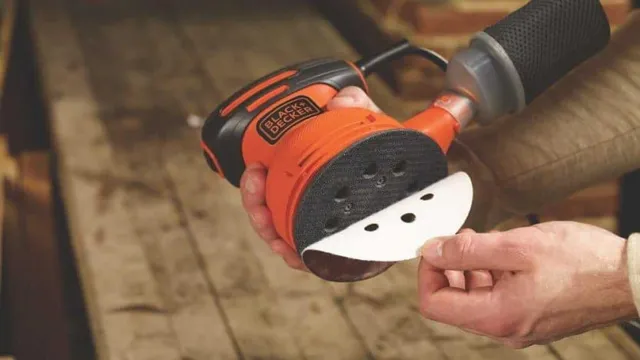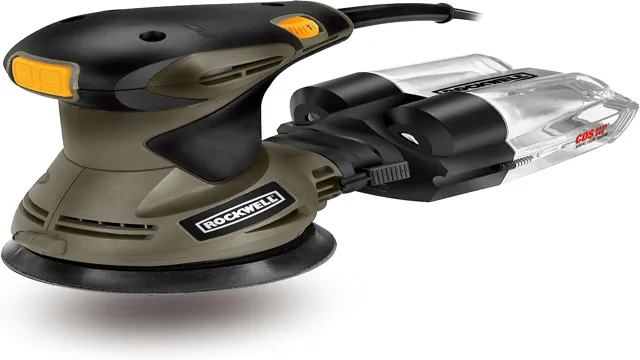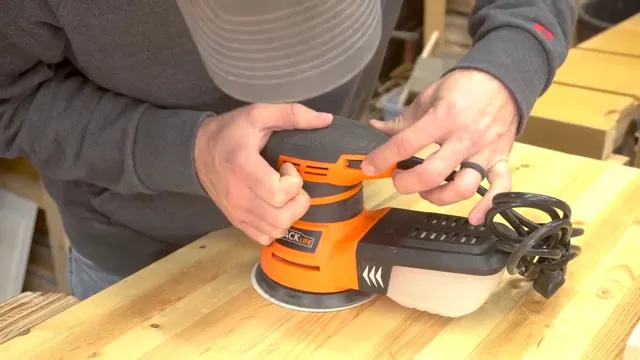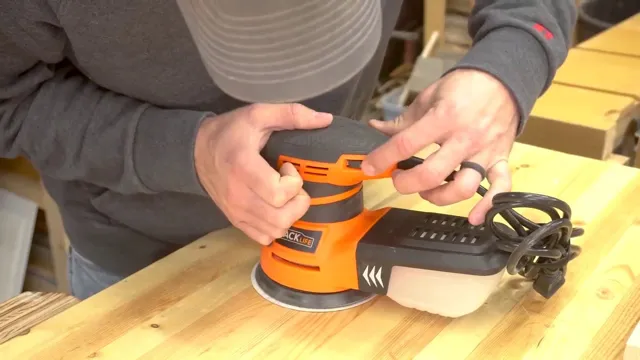How Long to Sand Deck with Orbital Sander – A Comprehensive Guide for Quick & Effective Results
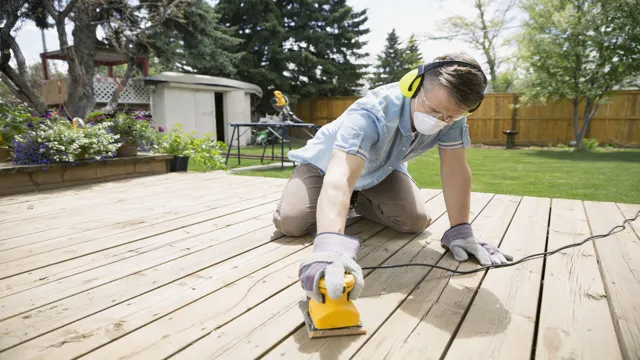
Do you have a worn-out deck that needs a little TLC? Sanding it down can do wonders for its appearance and longevity. And if you’re looking for a reliable tool to help you get the job done, an orbital sander is just what you need! An orbital sander is a handheld power tool that can be used for a variety of sanding tasks. It works by vibrating in tiny circles, which helps it achieve a smooth, even finish on your deck.
With its compact size and easy-to-use design, an orbital sander is a great choice for homeowners who want to tackle DIY projects themselves. When it comes to sanding your deck with an orbital sander, there are a few things to keep in mind. First, you’ll need to choose the right sandpaper grit for your project.
If your deck is in rough shape and has a lot of rough spots and stains, you’ll want to start with a coarse grit sandpaper. Then, you can work your way up to a finer grit for a smoother finish. Another important consideration is safety.
Make sure you wear protective gear like goggles and a dust mask to keep your eyes and lungs safe from flying debris. And be sure to use the orbital sander properly, following the manufacturer’s instructions and taking regular breaks as needed to give your arms a rest. Overall, sanding your deck with an orbital sander can be a fun and rewarding DIY project.
With a little time and effort, you can restore your deck to its former glory and enjoy it for years to come.
Factors Affecting Sanding Time
If you are wondering how long it takes to sand a deck using an orbital sander, there are several factors that can affect the sanding time. First, the size of the deck plays a huge factor on how long it takes. Larger decks will require more time than smaller ones.
The condition of the deck is also a factor because if it is heavily weathered or damaged, it may require more time to sand down to a smooth surface. Another factor is the grit of the sandpaper being used. Coarse sandpaper will remove more material but will take longer to achieve a smooth surface.
Finally, the type of orbital sander being used can make a difference. A smaller, handheld sander will often take longer than a larger, more powerful floor sander. All in all, the sanding time for a deck can vary from a few hours to several days depending on these factors.
It’s important to be patient and thorough to achieve the desired results.
Deck Size and Condition
When it comes to sanding your deck, one of the biggest factors that affects the time it takes is the deck size and condition. If your deck is small and in good condition, sanding it down will be a quick and easy task. However, if your deck is large or in need of repair, sanding it down can be a time-consuming and challenging process.
Not only will you need to spend more time sanding to achieve a smooth surface, but you may also need to make more repairs or replace damaged boards before you can even begin sanding. That’s why it’s essential to assess your deck’s size and condition before starting any sanding work. It will help you plan how much time and effort you’ll need to dedicate to the project and ensure that you achieve the best possible results.
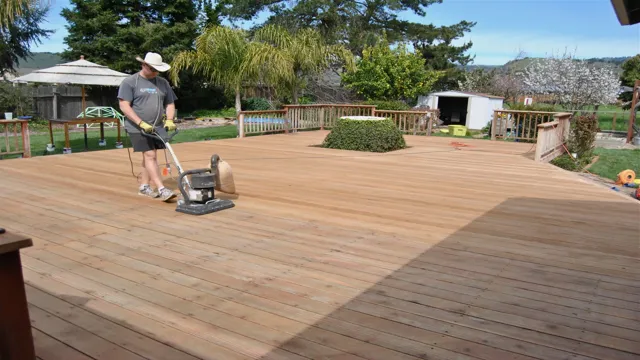
Grit of Sandpaper
Sanding wood can be a tedious process, especially if you don’t take into account the grit of the sandpaper you use. The grit refers to the abrasive particles on the sandpaper, and the higher the grit number, the finer the particles. This means that higher grit sandpaper will remove less material with each pass and create a smoother surface.
However, using a higher grit sandpaper doesn’t always mean a shorter sanding time. The type of wood you’re sanding, its hardness, and the shape of the object can also affect how much time it takes to sand. For example, sanding a flat surface will be faster than sanding a curved one, and sanding a softwood like pine will be faster than hardwoods like oak or maple.
It’s important to choose the right grit sandpaper for your specific task and take into account the other factors that can affect sanding time. By doing so, you can save time and energy in achieving the desired smoothness of the finished product.
Type of Orbital Sander
When it comes to sanding, the type of orbital sander you use can greatly affect how long it takes to achieve your desired results. Random orbital sanders are known for their efficiency and speed, as they move in a circular pattern while simultaneously vibrating the sanding disc. This helps remove material in a shorter amount of time, making them the ideal choice for larger projects.
On the other hand, sheet sanders move in a back-and-forth motion, which can take longer to achieve the same results as a random orbital sander. Another factor to consider is the grit of the sandpaper you use, as coarser grits will remove material quicker but with more visible marks, while finer grits may take longer but leave a smoother finish. Ultimately, choosing the right tool and sandpaper for the job can greatly impact your sanding time and the quality of your results.
Steps to Sand Your Deck
If you’re planning to sand your deck with an orbital sander, there are a few steps you should follow to ensure the best results. First, sweep or blow off any debris or dirt from the surface of your deck. Then, start with a lower grit sandpaper and gradually work your way up to a higher grit for a smoother finish.
Depending on the condition of your deck, this process can take anywhere from a few hours to a full day or more. Be sure to wear protective gear, such as goggles and a mask, to avoid inhaling dust particles while sanding. Remember to take breaks and hydrate often, too.
By taking the time to sand your deck properly with an orbital sander, you’ll be able to enjoy a smoother, more polished surface for years to come.
Clean the Deck Surface
Before you start sanding your deck, you need to clean the surface thoroughly. The first step is to clear the deck of any objects, including furniture, pots, or rugs. Sweep off debris and leaves with a broom, and move onto scrubbing the surface with a cleaning solution.
You can use a store-bought deck cleaner or make one yourself by mixing water, bleach, and detergent. Use a stiff brush or a power washer to remove dirt, stains, and mildew. Rinse the deck with a garden hose, and let it dry completely for at least 24 hours before sanding.
Cleaning is essential because sanding a dirty deck can create more problems than it solves. If you sand over rotting or decaying wood, you will expose more fibers and weaken the structure further. Moreover, sanding can spread mold spores, which can cause health issues if inhaled.
Therefore, take the time to clean the deck surface and eliminate any risks before proceeding with sanding. By doing so, you’ll ensure a smoother, safer, and more satisfying sanding experience.
Choose the Right Sandpaper
When getting ready to sand your deck, one of the most important things to consider is choosing the right sandpaper. It can make all the difference in the finished result. First, determine the type of wood your deck is made of, as softer woods will require a less abrasive sandpaper, while harder woods may require a coarser grit.
Next, decide on the grit size you need. If you’re starting with rough wood or need to remove old paint or stains, a lower grit such as 40 or 60 is recommended. For smoother wood, a grit of 80 to 120 should suffice.
It’s important to use a consistent pattern and apply even pressure when sanding, moving in the direction of the wood grain. And don’t forget to wear protective gear like gloves and a mask to keep yourself safe from dust and debris. With the right sandpaper and technique, your deck will be looking like new in no time.
Sand the Deck
If you’re planning to sand your deck, you’ll want to make sure you follow the proper steps to get the job done correctly. First, sweep the deck clean of any leaves, dirt, and debris. Then, use a deck cleaner specifically designed for your deck’s material to remove any grime and stains.
Once the deck is dry, it’s time to start sanding. Begin with a coarse-grit sandpaper to remove any blemishes or scratches, working your way to a finer-grit sandpaper for a smoother finish. Be sure to sand evenly and pay close attention to any corners or edges.
When finished, sweep or vacuum the area to remove any dust or debris. Taking the time to sand your deck thoroughly will not only improve its appearance but also extend its lifespan. So grab your sandpaper and get started on transforming your deck!
Vacuum the Deck
Sand Your Deck If you’re thinking of sanding your deck, there are a few crucial steps to follow to ensure the process is done correctly. First things first, you want to make sure the surface of your deck is clean, so vacuum any debris such as dirt or leaves before proceeding. Next, mark any areas that must be repaired, such as nails sticking out, so you don’t miss them while sanding.
You’ll then want to use a coarse sandpaper to sand down the deck’s surface. Make sure to wear protective clothing, such as goggles and gloves, as the sanding process may produce dust and debris that could be harmful to your eyes and skin. After you have sanded the entire surface, it’s time to vacuum again to remove any excess dust before proceeding with the next steps.
Sanding your deck can be a time-consuming process, but by following these steps, you can ensure it is done to a high standard, and you will have a beautiful, perfectly finished deck at the end.
Estimated Time to Sand a Deck with an Orbital Sander
If you’re wondering how long it would take to sand down your deck using an orbital sander, the answer depends on a few factors. Firstly, the size of your deck will definitely play a role in how long the job takes. Generally speaking, it can take anywhere from a few hours to a full day to sand a regular-sized deck.
Secondly, the condition of your deck will also affect the amount of time required. If your deck has been neglected for years and is covered in thick layers of paint or stain, it will naturally take longer to sand down. On the other hand, if your deck is relatively new and in good shape, the process will be much quicker.
Lastly, the type of orbital sander you use will also make a difference. A more powerful sander will make quicker work of the job, whereas a less powerful model will take longer. All in all, an estimate of 4-8 hours is usually a safe bet for sanding down a typical-sized deck with an orbital sander.
Factors to Consider
When it comes to sanding your deck, one of the factors to consider is the estimated time it will take with an orbital sander. Of course, the time it takes will depend on a number of variables, including the size of your deck, the condition of the wood, and the grit of sandpaper you choose to use. As a general rule, a smaller deck in good condition could take around 4-8 hours to sand with an orbital sander, while a larger deck in need of more extensive work could take up to 12-16 hours.
Additionally, using a finer grit sandpaper will result in a smoother and more polished finish, but will also take longer to achieve. It’s important to keep in mind that sanding your deck can be a time-consuming process, but it’s well worth the effort to achieve a beautiful and long-lasting finish.
Steps to Calculate Sanding Time
Sanding a deck is a crucial step in ensuring that it looks its best. But, it can be a tedious and time-consuming process if you’re not equipped with the right tools and knowledge. To estimate the time needed to sand your deck, you will need to consider a few factors.
The first thing to think about is the size of your deck. The larger the deck, the longer it will take to sand. Next, you will want to consider the condition of your deck.
If it’s in good condition, it will take less time to sand than if it’s in poor condition. The type of sander you are using will also play a role. An orbital sander is a common choice for sanding decks, and it should take anywhere from 4-8 hours to sand an average-sized deck with this type of sander.
It’s important to note that this estimate can vary depending on your experience level, the condition of your deck, and the type of sander you’re using. So, take your time, and don’t rush the process. The end result will be a beautiful deck that you can enjoy for years to come.
Example Calculation
If you’re thinking about sanding your deck with an orbital sander, one of the first questions you’re likely to ask is “How long will it take?” The answer depends on a number of factors, including the size of your deck, the roughness of the surface, and the power of your sander. Generally speaking, a 12′ x 12′ deck with moderate roughness can be sanded in about 10 hours using a standard orbital sander. However, if you’re using a more powerful sander or have a particularly rough surface, it may take longer.
It’s also important to keep in mind that sanding a deck can be a time-consuming process, and it’s easy to miss spots or leave uneven patches if you’re not careful. To speed up the process, you may want to consider using a belt sander or a power washer to remove some of the surface material before you begin sanding. With a little patience and some hard work, you can have a beautiful, smooth deck that’s ready for staining or painting in no time!
Tips to Speed Up Sanding Process
If you’re wondering how long to sand your deck with an orbital sander, the answer can vary depending on the size of your deck and the condition of the wood. However, there are some tips you can follow to speed up the sanding process. Firstly, you can use a coarser grit sandpaper to remove any rough patches or stubborn stains quickly.
Once you have removed the rough parts, switch to a finer grit sandpaper to create a smoother finish. It’s also essential to use a dust collection system while you’re sanding to prevent excess dust from settling on the wood and causing damage. Lastly, take breaks regularly to avoid fatigue and to give the sander a chance to cool down.
With these tips, you’ll be able to sand your deck quickly and efficiently with an orbital sander.
Use a Belt Sander for Large Decks
When it comes to sanding large decks, using a belt sander can be a game-changer. This powerful tool packs a punch and can quickly remove old finishes and rough patches. But how can you speed up the sanding process even more? One tip is to purchase sandpaper in bulk, so you don’t have to keep stopping and starting to change out sheets.
Another idea is to have multiple belt sanders on hand, each with different grits of sandpaper so you can switch between them easily. It’s also crucial to wear protective gear like gloves and goggles to stay safe while using the belt sander. By following these tips and utilizing the power of a belt sander, you’ll be able to sand your large deck in no time.
Replace Sandpaper Regularly
One of the key ways to speed up the sanding process is by replacing your sandpaper regularly. Over time, sandpaper can lose its grit and become less effective, which can slow down your progress and lead to frustration. By swapping out your sandpaper frequently, you can ensure that you always have a fresh and sharp surface to work with.
This will mean you can work faster and achieve smoother, more even results. So, whether you’re sanding a piece of furniture or finishing a DIY project, make sure to keep an eye on your sandpaper and replace it as needed. With this simple hack, you’ll be able to save time and enjoy better results, no matter what you’re working on.
Work in Sections
When it comes to sanding, it can be a tedious and time-consuming task. However, by breaking your work into sections, you can speed up the process and get a better result. Start by dividing your work area into manageable sections, and tackle one at a time.
Not only will this help you stay focused, but it will also prevent you from becoming overwhelmed. Additionally, by working in smaller sections, you will be more likely to notice any imperfections or areas that require more attention. So, next time you are faced with a sanding project, try breaking it into sections to save time and achieve a flawless finish.
Final Thoughts
When it comes to sanding your deck with an orbital sander, the time it takes can vary depending on the size of your deck and the condition of the wood. In general, sanding a deck with an orbital sander can take anywhere from several hours to a full day or more. It’s important to note that proper sanding technique is crucial in achieving the best results.
Start with a coarse grit sandpaper and gradually work your way up to a finer grit for a smooth finish. Be sure to take breaks and wear protective gear to avoid injury and exhaustion. While the process can be time-consuming, the end result of a beautifully restored deck is worth the effort!
Conclusion
After much sanding and contemplation, the answer to the proverbial question of “how long to sand deck with orbital sander?” is simple – it depends. It depends on the size of your deck, the condition of the wood, and your personal sanding technique. But fear not, with focus, determination, and a trusty orbital sander, you can transform your deck into a thing of beauty.
So, don’t rush the sanding process, take your time, and enjoy the journey to a perfectly sanded deck. Happy sanding!”
FAQs
What is an orbital sander and how does it work?
An orbital sander is a power tool used for sanding wood or other surfaces. It works by moving the pad in small circular orbits, creating random patterns which help to prevent swirls.
How long does it take to sand a deck with an orbital sander?
The amount of time it takes to sand a deck with an orbital sander depends on the size of the deck and the condition of the wood. However, on average, a 200 square foot deck can be sanded in approximately 3-4 hours.
What type of sandpaper should I use with an orbital sander when sanding a deck?
It is recommended to use a coarse grit sandpaper, such as 60 or 80 grit, to remove any old finish and prepare the wood surface for further sanding with a finer grit sandpaper.
How often should I change the sandpaper on my orbital sander when sanding a deck?
It is recommended to change the sandpaper every 30-60 minutes, or when the sandpaper becomes clogged and no longer effective.
Can I use an orbital sander on a wet deck surface?
No, it is not recommended to use an orbital sander on a wet deck surface, as this can damage the tool and potentially cause an electric shock.
Should I wear safety gear when using an orbital sander on a deck?
Yes, it is recommended to wear safety gear, such as goggles and a dust mask, when using an orbital sander on a deck to protect your eyes and lungs from dust particles.
Can I sand a painted deck with an orbital sander?
Yes, an orbital sander can be used to sand a painted deck, but you will need to use a coarse grit sandpaper to remove the paint first before switching to a finer grit sandpaper for further sanding.

